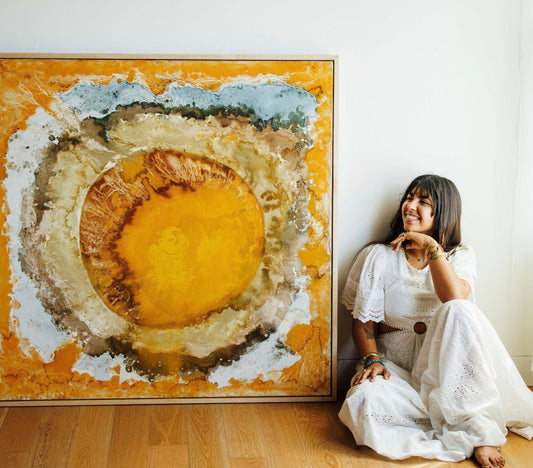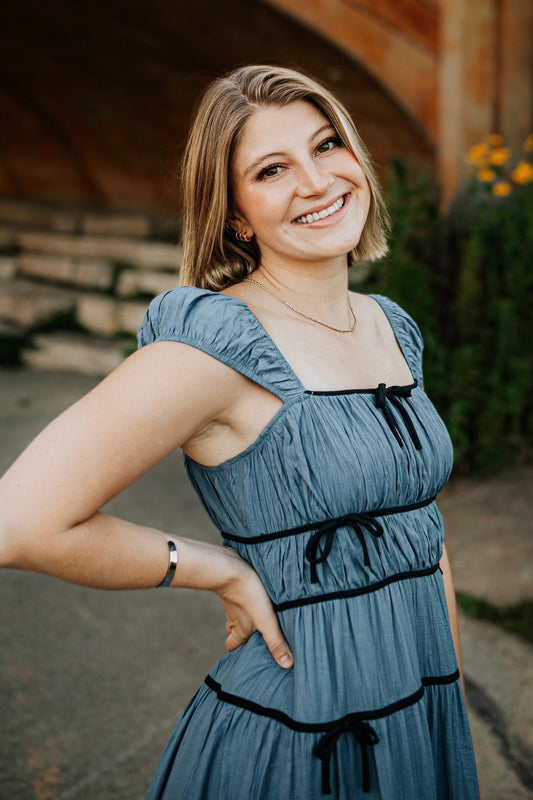Tulips in a Wheatfield
It all started with the idea that a picture frame is a window that can be an entrance into an imaginary universe where the laws that bind our daily life no longer exist. The picture in the frame is of tulips in a wheatfield—a beautiful rarity—the nude and bare earth sprouting vibrant shades of color, an imaginative wonderland. This is what Daniel Mullen is. It is who he is, an artist filling the world with color. Much of Daniel’s work is based on a concept he learned in art school. Emptiness versus nothingness. In Western philosophy, Sartre would say that the “state of emptiness is a negative state of being and something that we should be striving toward would be nothingness as a positive state of being.” It truly is genius how Daniel Mullen, a Scottish-born and Netherlands living artist, is able to take philosophy and turn it into art. Because isn’t art in its core a philosophical state of creation?

The Wondrous Wizard of Oz: Daniel Mullen
This is how life started for Daniel Mullen: imaginative, beautiful, and full of color. Through his education at the Waldorf school, there was a heavy emphasis put on the artistic development of the child. He was exposed to “creative forms as ways to express yourself [himself].” Daniel always had an “affinity for the arts,” whether this was with music, drama, or the visual arts. His creativity was always fostered in every way possible. Daniel was an artist, born and raised.
But he really knew art was going to be his muse at a young age, when he was asked to work on a set for the Wizard of Oz in Upstate New York. Daniel was given free rein to paint whatever he desired on the set with the original movie in mind, and through the first couple of weeks, he became immersed in painting and in months, Daniel had lost himself to the wondrous and magical Wizard of Oz set that he helped create. He soon realized he wasn’t in Kansas anymore, but in a whole different world. Daniel said it was “kind of in a way an epiphany that this is how I want to spend all of my life.” So shortly after his residency in New York, Daniel went to art school in the Netherlands, a place where he tenderly created his unique niche that can only be explained as an exhale of colors and emotions. A visual firework of gently painted yellows, blues, and greens that explode into sheer hues. Moving from stage lights and set props to the walls of world-renown galleries has given Daniel his household name in the genre of “optical illusionistic color field abstraction.”


Defining what it means to be successful, for different artists, can mean a million different things. It can mean selling five original works or commissioning twenty pieces in a month, but to Daniel, it is for people to appreciate the beauty of his art or to appreciate the feeling of deciding what his art means for oneself. His work doesn’t necessarily live online, but it lives on the walls of galleries. Being looked at by thousands of different people from thousands of different walks of life. His work speaks to people around the world, so it comes to no surprise that his work has been seen in twenty-one group shows and six solo exhibitions in the last eight years. This is because viewers see the honest work and technique Daniel Mullen has put into each and every one of his pieces, along with the visually appealing optical illusions. Galleries cannot get enough of Daniel’s unique work—it all boils down to how and what he chooses to create. And it all starts with a question.
An Exhale of Emotion
“What do I want to explore?” Whether it is the dimensional planes of an isosceles triangle or how to layer colors one on top of the other to get a shade so close to black it is almost unsettling to the viewer, Daniel Mullen is always asking questions. This is all the planning he needs when it comes to his work on 200cm by 300cm raw linen; Daniel is extremely intuitive with the size of the linen and how his hands cascade down a blank sheet with a paintbrush. After figuring out what he wants to explore, Daniel doesn’t use Adobe or projections, but instead he is old-fashioned and uses a “long wooden stick and a pencil” to measure out each and every one of his dimensions. His newest shape comes to him almost as naturally as breathing. Other times he will be “standing in front of the canvas and I don’t know what I’m going to do and then I just start.” Everything after this is what Daniel refers to as his “systems,” developments that are trustworthy and time-tested that give his work that “je ne sais quoi.”
Daniel’s work is the definition of blood, sweat, and tears. After hand stretching, a process that is not common to an untrained artist, he paints six layers of smooth, transparent acrylic primer onto the raw linen and then sands it down to get the smoothest surface possible. This “allows for straighter lines, and also for the tape to sit on the canvas well.” There is a methodical system to canvas preparation before the painting even begins.


After Daniel has created the perfect shapes for his piece, what comes next is color. The end all, be all of his work, the reason why they exist—to explore color in a world of empty canvases. During our interview, Daniel shared his Zoom screen from all the way in the Netherlands to show a piece that technically had two colors, but to the naked eye, it was an explosion, a plethora of shades of magenta and a glowing baby blue. To ensure his work gives the optical illusion he’s going for, Daniel overlaps the colors in layers as he moves to the center of the painting, allowing them to dry before adding a clear layer of acrylic paint, then adding another layer of color. The closer one moves to the painting, the more they see how translucent the piece actually is. And in the center, much like the Earth’s core, there are so many overlapping layers of paint that it almost looks black, while in reality it is just a mixture of magenta and blue—there is no mixing of colors. This is a memorandum to the dedication Daniel has to his work; he is willing to wait hours for paint to dry for his method to work.
Absolutely everything in Daniel’s work is precise. He leaves nothing to chance except for the sparse bleeding of colors or the slip of the hand. But Daniel does not go back to cover them up because, “you really see the hands of the maker. I don’t want to make prints, I want to make paintings… it’s in these little imperfections where beauty exists.” He describes it as having this feeling of “being able to look at something for a super long time because you don’t quite understand it.” Because if something is too perfect, there is nothing to be discovered. There are no hidden secrets from the artist, no sign that he or she was human—that's what art is. The visual history of what it means to be a human being. Daniel’s art, for example, represents human emotion because it makes viewers feel something, it makes them feel anything.

Emptiness versus Nothingness
As mentioned previously, Daniel got his BFA in fine arts from Gerrit Rietveld Academie in Amsterdam, Netherlands, where there was a large focus on architectural aspects to the fine arts. What is more interesting is Daniel’s relationship to absence—how might he illustrate this on a canvas? Or how can he remove the concept altogether? This started Daniel’s journey into architecture as being a placeholder for emptiness. Daniel wants us to think of architecture like a scaffold, the bare bones of a piece—it is just there in order to create a “volume or a space for the imagination of the viewer.” He described it as “in the end, it started that broader theme of leaving the narrative aspect behind.” This is precisely why there is no narrative in any of Daniel Mullen’s pieces. Viewers do not exactly know where to look, so they look anywhere on the raw linen and create a story of their own that’s worth telling.
In the juxtaposition of emptiness and nothingness, the approach of emptiness is actually a positive state of being that resonates with Daniel, contrary to Western philosophy. This is because being empty is already something unlike nothingness—so in the context of a white canvas, it is literally a void of nothingness, “a negative experience” because the canvas has been bleached white—i’s unique properties are thus washed away with the organic beige color. h. In opposition to this, raw linen is just empty—it has yet to be tampered with as it represents an endless opportunity to simply create on a raw surface. Daniel feels as though he can interact with it in a positive way. It somehow felt like “a universe” that had yet to be explored, the dark side of the moon, whereas the white canvas gave Daniel that feeling that he needed to paint over it. He realized that the whole canvas did not need to be painted over for it to seem full and vibrant. There needed to be a relationship between emptiness and what he was creating.


Current Projects + What’s Next
Recently, Daniel has moved some of his pieces from the canvas to a shaped wooden panel in order to test the relationship between the panel and the wall. His work is very methodical and almost scientific in the way he goes about exploring new techniques and niches. Instead of having the boundaries of the canvas act in isolation to the walls, the shaped wooden panel acts as a part of the wall, making the experience of the painting more intense. Daniel said it could potentially be a slow evolution to doing more three-dimensional work, but don’t expect this for “quite a few years.”
More excitingly, Daniel has a show coming up this November in Brazil where he gave a sneak peek of his newest pieces over our zoom call, sitting behind him just over his paint-ridden shoulders. Before that, he is going to Mexico City for an artist residency which will further allow him to develop his research in color vibrations and push it further. For those U.S. bound this fall, his next show will also open in November in Idaho with works he did with his wife Lucy who has synesthesia. The year after, Daniel had a joint exhibition in Milan.
Daniel Mullen has been up and coming for the past decade, but in 2022 his work and research into color theory will transcend his work into that seen in art history textbooks. His experience with philosophical ideals in relation to his work is what makes it so appealing to the human eye—its architectural abstract qualities pull viewers in and the immense explosion of color keeps them there.
©ArtRKL™️ LLC 2021-2023. All rights reserved. This material may not be published, broadcast, rewritten or redistributed. ArtRKL™️ and its underscore design indicate trademarks of ArtRKL™️ LLC and its subsidiaries.





